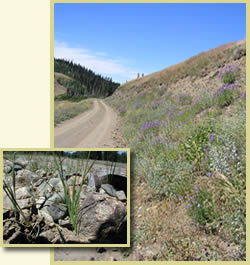USDA Forest Service Celebrating Wildflowers
|
|
|
 |
|
Developing Native Plant Materials for RestorationSpecies Selection The native species most appropriate for a particular planting project depends on important site factors such as moisture, light, and nutrient availability. Planting a diversity of species is usually desirable, and may make sites more resistant to weed invasion and establishment. Information and resources that help identify the best choice of native species to use in a project include:
 The species most commonly used in revegetation projects are referred to as “workhorse” species. These include species, such as mountain brome or blue wild rye in the western United States, that are quick to establish and can grow well on disturbed sites with little assistance from irrigation or fertilizer. When large quantities of plant materials are needed, an additional important consideration in species selection is the ability to propagate plants in a nursery or seed increase field. Propagation methods for many native plant species are unknown or poorly understood. Forest Service researchers and other scientists are working to develop more effective seed treatments, and germination and propagation protocols. For more information on native plant species and their attributes, visit:
|
|
| NOTE: PDF format links require the Adobe Acrobat Reader to view. | |
| top | Disclaimers | FOIA | Privacy Policy | Quality of Information | Photo Credits & Use |
Location: http://www.fs.fed.us/wildflowers/nativeplantmaterials/speciesselection.shtml
Last modified: Tuesday, 24-Jun-2008 21:54:57 EDT
